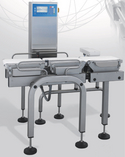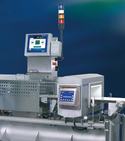Quality demands drive technology
21 June 2006Increasing regulatory demands and the requirement for both processors and retailers to provide high quality goods at a competitive price are driving weighing and inspection technology. Rod Abbott reports
Growth in the chilled food sector over the past five years has led to greater demand for more flexible and robust checkweighers. The perishable nature of such products and the requirements of high-speed production environments demand checkweighers that can operate 24/7 with rapid changeovers and maximum uptime.
“Advances in electronics and networking solutions have made operation more user-friendly with easy-to-use graphical touch screens and have made more information on weight data and trends available,” explains Loma/Cintex’s group product manager Alan Johnson. “This information can be used off-line to improve production line efficiency.”
Major improvements in hygiene have also been made with the introduction of R51 Approval in Europe, which has led to improvements in accuracy, stability and immunity for accredited machines.
“Metal detection technology has also developed with particular growth in machinery providing a number of operating frequencies,” adds Johnson. “This was initially driven by the advent of metallised film which required two frequencies, but was developed further as a means of producing metal detectors where frequency did not have to be determined by the product being inspected.” Cintex’s Sentry VF, reputed to be the only true multi-frequency metal detector on the market, is said to be leading the way in this new technology.
HACCP compliance in the food industry is also driving technology in metal detection with great improvements in software and report capturing networks. Hygiene is also a major factor and machine-build is now taking this into account. “Supermarkets have also been influential in directing metal detection technology”, says Johnson. “With new codes of practice for supermarket suppliers now in place, failsafe features like ‘line-block’, ‘reject-confirm’ and ‘bin full’ are becoming commonplace.”
Another key area in codes of practice is the recommended use of X-ray for products packed in foil. To meet these needs, Cintex’s Sentry XR has recently undergone a number of developments for improved accuracy, reliability, safety and longevity. This technology is said to be priced in-line with conventional metal detectors, making it more accessible for manufacturers requiring the precision and consistency of X-ray inspection at entry-level costs.
Johnson observes that “increasing rationalisation and just-in-time pressures in the food industry have meant that reliability is now all-important, manifesting itself in more robust designs of drive systems – motors, bearings, shafts and rollers. Conveyor belts have also had to become more robust with modular belts, such as those produced by Intralox, being specified in preference to the flat PU type belts.
“Continuous innovation in the food industry and the race to be ‘first-to-market’ with a new product often leads to inspection equipment being left as an after-thought. Currently, rapid delivery of bespoke equipment that 'works out of the box' is probably the biggest challenge for checkweigher and metal detector manufacturers,” concludes Johnson.
Business manager of Mettler-Toledo’s product inspection division Mike Bradley adds: “Perhaps the greatest change of all has been the increased uptake in X-ray based product inspection technologies into areas where they deliver real life customer benefits. With the greater use of aluminium foil and metallised film in food packaging, several retailers have now made it part of their standard codes of supplier practice that food producers use X-ray based solutions, rather than conventional balanced coil metal detection systems to detect unwanted metallic contamination.”
The physical size and shape of detection technologies has not changed significantly. This is due in part to the fact that product inspection processes tend to be application driven. Consequently, unit footprints are not significantly smaller than they were five years ago. Key advancements, however, have been made in other areas as a result of changing producer requirements.
Constantly expected to produce better quality foods, faster and to be more competitive, food producers strive to achieve maximum machine uptime, speed and reliability. As proof of machine capability, individual Key Performance Indicator statistics (the industry standard for measuring efficiency performance and capability) are also frequently requested.
In short, it’s no longer simply about being able to supply a quality checkweigher or metal detection product but in providing 24/7 service and technical support to ensure minimum downtime.
“Specialist failsafe features such as machine ‘condition monitoring’ are now frequently specified by product inspection purchasers and considered as essential. Such precautions continually monitor critical elements of the operating status of a metal detector or checkweigher to provide early warning of any deviation from normal operation and allow for scheduled and planned maintenance,” says Mettler-Toledo’s Bradley.
A recent key change to Anritsu Industrial Systems’ range of pharmaceutical checkweighers, distributed by Selo-Bollans, has been the introduction of new weighcells to provide accuracy of 2mg at 600 packs/min. In metal detection, the trend towards increased use of foil and foil laminates resulted in Anritsu’s development of the M series of metal detectors, incorporating a high-intensity permanent magnetic field prior to the detection head. The system is reputed to be able to detect contaminants even in foil pouches.
Anritsu’s dual-wave metal detector and associated software, now standard on all models, features twin frequencies. This automatic self-calibrating system uses real product to determine its best combination of the two frequencies and ensures it is running at optimum sensitivity.
Many lines require both metal detection and checkweighing and Anritsu’s combined machines have a significantly smaller footprint than standalone models. They also share software and statistical functions, enabling combined statistics to be produced with ease. “A challenge for the future is likely to be a requirement for individual pack traceability, particularly combined with X-ray systems and this technology is already on test at Anritsu,” says sales and marketing director Chris Williams.
Richard Lines, managing director of S+S Inspection, says “there has been a greater emphasis on digital signal processing and the provision of on-line data and event logging systems to flag-up faults and on line occurrences.”
S+S Inspection has launched an X-ray inspection system specifically for small products. The new Raycon XS is only 1300mm long, making it easy to integrate into existing packing lines. The 200mm wide conveyor belt of the new model is suitable for products with a maximum width of 165mm and maximum height of 105mm.
With throughput of up to 400 units/min, the Raycon XS is said to provide a cost-effective solution for the inspection of small packs of butter, cheese, instant soups and other powder mixes, meat and sausages, even when aluminium foil or metallised film packaging is used.
UK-based Panesar Foods has invested in metal detection equipment from S+S Inspection for both in-production and end-of-line product inspection to ensure compliance with HACCP. All Panesar sauces and pastes at its West Bromwich site are checked for metal contamination using an S+S Liquiscan in-line metal detector. This is located between the production area and the filling line where two S+S conveyor based units are used at the end of the filling line as a final check before capping. This approach is said to ensure that there is no possibility of any metal contaminated product leaving the factory.
Advanced product recognition technology is featured on Ishida Europe’s DACS-W series, which can be specified with a camera that allows pack images to be stored in the checkweigher for immediate recognition, enabling product set-up and changeovers to be carried out “in seconds” without additional operator intervention.
The camera forms part of a powerful, intuitive graphic interface on the DACS-W that is said to simplify operations and speeds up training. The swivel-mounted colour touch-screen provides easy to follow instructions for line operators with on-line help, self-diagnostics and fault finding.
Improved networking capabilities allow centralised control and provide detailed information to ensure efficient management of operations across single or multiple sites. The DACS-W-012 can handle products from 10g to 1.2 kg at up to 270 packs/min.
Three Ishida multihead weighers have been installed at German potato producer Friweika’s factory in Weidensdorf, Saxony. A 10-head Ishida weigher is operating as part of the processing system for fresh potatoes while the automated lines for the prepared varieties, which start with washing and peeling machines and finish with the sterilisation of packed product, feature a 10-head and a 16-head model.
There are always about 6 tons of potatoes on a production line and three hours must be allowed for them to pass from the first work station to the last. If one machine is not operational, the part of the production batch already on the line must be discharged. Upstream of an Ishida weigher, this would amount to about 2.5 tons of product. The additional amount of work involved is enormous and large production losses can be incurred after just a short period of downtime.
As fresh potatoes are impact-sensitive, Bancollan [a polyurethane-based material] is employed to help control the transfer to the top of the weigher and within the machine. This protects the potatoes by decelerating the product flow through the hoppers and the discharge chute.
Operation speeds range from 10 packs/min for 10kg packs to 60 packs/min for the 250g sizes, where higher output is only limited by the thermoforming machine. Compared to figures achieved on the linear weigher that was previously employed at Friweika on 500g trays of sliced potatoes, the Ishida machines have reputedly achieved a 20% increase in output, a 50% increase in weighing accuracy and a product saving of 10%.
GSH Group company Easiweigh has introduced a new checkweigher for environments with high humidity levels such as the fresh and frozen food sector. It has been developed to ensure products exactly match the specified weights required on the production line and reportedly achieves ±0.3g accuracy levels at speeds of up to 300 products/min.
Easiweigh software can store up to 100 product programmes for simple recovery when required. The weigher can be applied to an end-of-line process or integrated within existing packaging or bagging operations. Produce can be checkweighed either with or without its packaging.
The new Vantage high-speed, in-line checkweigher from the Stevens Weighing Group is intended for the pharmaceutical and personal healthcare industries. Its minimalistic design facilitates cleaning and the wireless LAN-enabled interface is designed to ensure optimum data security and location versatility. The product can operate as a stand-alone system or as part of a network and is capable of weighing speeds in excess of 200 items/min. The set up can be carried out locally through the touch screen console or from a central PC. A key feature is that modules are not dependent on the system in which they are operating. The Vantage will continue to store and send back data even if there is a data transfer breakdown from the main line.
The Ceia THS/PH21 pharmaceutical metal detector from Constant Instruments has been designed to inspect pharmaceutical products where there is a need to confine the active ingredients within the transit tunnel of the detector. It does this by enabling end of batch wash-down and hygienic decontamination of all contact parts while the metal detector remains in position. This permits subsequent processing of different product types by eliminating the risk of contamination by residuals from a previous product.
All mechanical components, including entry and exit terminals, the transit conduit and the ejection unit, are sealed. Materials used in the metal detector’s construction do not interact with pharmaceutical products and will not modify or alter their composition says Constant Instruments.








